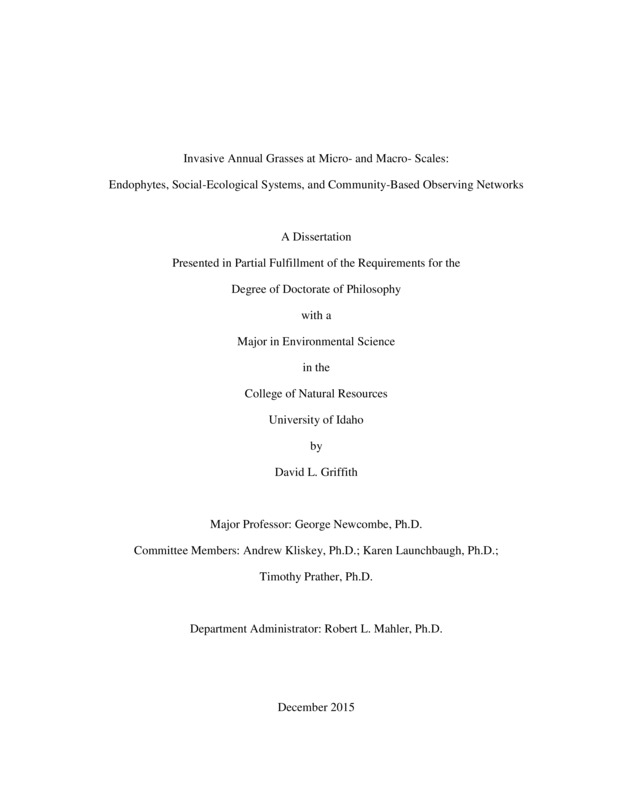Invasive Annual Grasses at Micro- and Macro- Scales: Endophytes, Social-Ecological Systems, and Community-Based Observing Networks
Griffith, David LaMond. (2016). Invasive Annual Grasses at Micro- and Macro- Scales: Endophytes, Social-Ecological Systems, and Community-Based Observing Networks. Theses and Dissertations Collection, University of Idaho Library Digital Collections. https://www.lib.uidaho.edu/digital/etd/items/griffith_idaho_0089e_10797.html
- Title:
- Invasive Annual Grasses at Micro- and Macro- Scales: Endophytes, Social-Ecological Systems, and Community-Based Observing Networks
- Author:
- Griffith, David LaMond
- Date:
- 2016
- Keywords:
- endophyte fungi Fusarium invasion ecology observing networks social-ecological systems
- Program:
- Environmental Science
- Subject Category:
- Environmental science; Ecology; Social structure
- Abstract:
-
Biological invasions by exotic plants have economic impacts and control costs in the United States on the order of tens of billions of dollars per year. Some of the most significant plant invaders have transformed landscapes and social-ecological systems, and yet mechanisms of invasion and management strategies are often incompletely understood due to mismatches in scale between social and ecological processes. The studies presented here include both micro-scale studies of the ecological effects of fungal endophyte infection on invasive grass productivity and community structure and the adaptation of a social-ecological systems science tool to the study and management of invasive plants at the regional scale. The first set of experiments discussed focus on the effects of Sordaria fimicola on the fecundity and growth characteristics of Bromus tectorum, and the results are interpreted in the context of the Habitat-Adapted Symbiosis Hypothesis. S. fimicola differentially affects the growth and fecundity of B. tectorum depending on site characteristics and timing of inoculation, suggesting that future research into the biocontrol potential of the dung fungus may be warranted. The second set of experiments assess the range of symbiotic relationships between new invader Ventenata dubia, competitors B. tectorum and Pseudoroegneria spicata, and a set of Fusarium spp. endophytes and pathogens isolated from B. tectorum and V. dubia. The results suggest limited support for the hypothesis that V. dubia is benefitting from symbiosis with Fusarium spp. that can simultaneously act as pathogens of its competitors in the invaded range, and that this may contribute to the annual grass’s ability to invade both B. tectorum monocultures and remnant Palouse Prairie remnants. The final section focuses on the potential use of Community Based Observing Networks (CBONs) for monitoring environmental and social factors associated with mechanisms and impacts of plant invasion.
- Description:
- doctoral, Ph.D., Environmental Science -- University of Idaho - College of Graduate Studies, 2016
- Major Professor:
- Newcombe, George
- Committee:
- Kliskey, Andrew; Launchbaugh, Karen; Prather, Timothy
- Defense Date:
- 2016
- Identifier:
- Griffith_idaho_0089E_10797
- Type:
- Text
- Format Original:
- Format:
- application/pdf
- Rights:
- In Copyright - Educational Use Permitted. For more information, please contact University of Idaho Library Special Collections and Archives Department at libspec@uidaho.edu.
- Standardized Rights:
- http://rightsstatements.org/vocab/InC-EDU/1.0/

